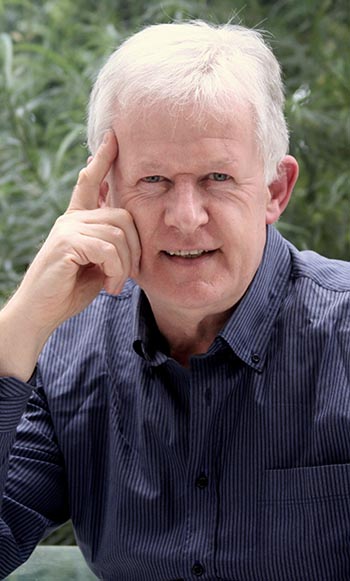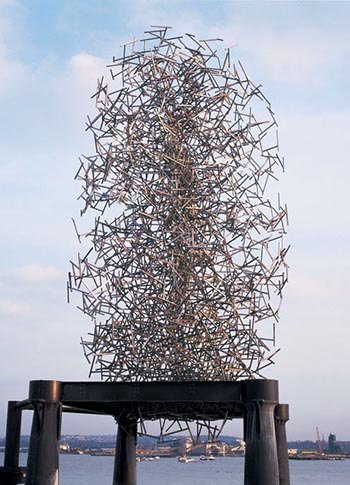|
home | what's new | other sites | contact | about |
||
|
Word Gems exploring self-realization, sacred personhood, and full humanity
Quantum Mechanics
return to "Quantum Mechanics" main-page
from https://besharamagazine.org/remarkable-lives/david-bohm-infinite-potential-paul-howard/
Infinite Potential: The Life & Ideas of David BohmDirector Paul Howard talks about his new film on a remarkable scientist whose vision of wholeness and interconnectivity is now reaching a wide audience  David Bohm (1917–92) has been described as one of the most significant thinkers of the twentieth century. As a theoretical physicist, he developed a radical approach to quantum mechanics which proposes that wholeness and interconnectivity are the fundamental principles of reality. But his interests and influence extended beyond the confines of science to the realms of philosophy, spirituality and social change. Earlier this year, we published an interview we did with him in 1991 (click here). Now a film has been made about his life and ideas which brings together an impressive array of contemporary thinkers who are taking his vision forward. Paul Howard, its director, talks to Jane Clark and Michael Cohen about the making of the film and Bohm’s importance for the world today. The film will hopefully be on general release in New Year 2021, but it is already available for purchase. Click here. If you type BOHM into the code box at purchase, you should get 10% off.
Infinite Potential begins with a story by Bohm’s one-time student Dr David Schrum: “It was night and we were walking under the stars, a black sky. David looked up at the stars and said: ‘Ordinarily, when we look to the sky and we look at the stars, we think of the stars as objects far out and that they have space in between them. But there is another way we can look at it. We can look at the vacuum, the emptiness, as a plenum, as infinitely full rather than infinitely empty, and that the objects are like little bubbles – little vacancies – in that vast sea.’ So he had me look at the night sky in a different way – as one living organism.” This conversation serves as a good introduction to Bohm’s most important theory – the idea of the implicate order – which, as the film goes on to demonstrate, has the potential to overturn our ideas about the world and about ourselves as radically as the heliocentric universe of Copernicus did in the seventeenth century. As a theoretical physicist Bohm was driven by the desire to resolve the deep mysteries thrown up by quantum theory, and the need to reconcile it with the other great pillar of contemporary science, Einstein’s theory of relativity. But, as Paul Howard is keen to emphasise, Bohm’s scope was far wider than that. He was interested in the nature of thought and consciousness, and developed close relationships firstly with the Indian sage/philosopher Jiddu Krishnamurti and later the Dalai Lama, who called him his ‘science guru’. He also had a life-long concern with social and political change; he developed a new form of communication, called Bohm Dialogue, which aims to break through our collective modes of habitual thought, and spent time with the Blackfoot or Siksika Native Indian people, searching for a new form of language in which to express ideas in a more process-oriented way.  Portrait of David Bohm by Mark Edwards.
Although it concentrates upon the physics, these wider aspects of Bohm’s thought are also covered in the film, which brings together a remarkable group of people, including the Dalai Lama and artist Sir Antony Gormley, distinguished scientists such as Sir Roger Penrose, Basil Hiley and Yakir Aharonov, and philosophers such as Paavo Pylkkanen and Augusto Sabbadini. Paul never met Bohm but was introduced to his ideas by his long-time friend and biographer David Peat, founder of the Pari Centre for New Learning [/], and was inspired by them. The film is clearly a labour of love; he not only produced it, but also wrote it, directed it and performs the voice-over. We spoke to Paul in his home in Dublin... So how has this worked? “Well actually, it has been extraordinary. To date, more than 400,000 people worldwide have watched the film, which is far more than would have done at festivals.” 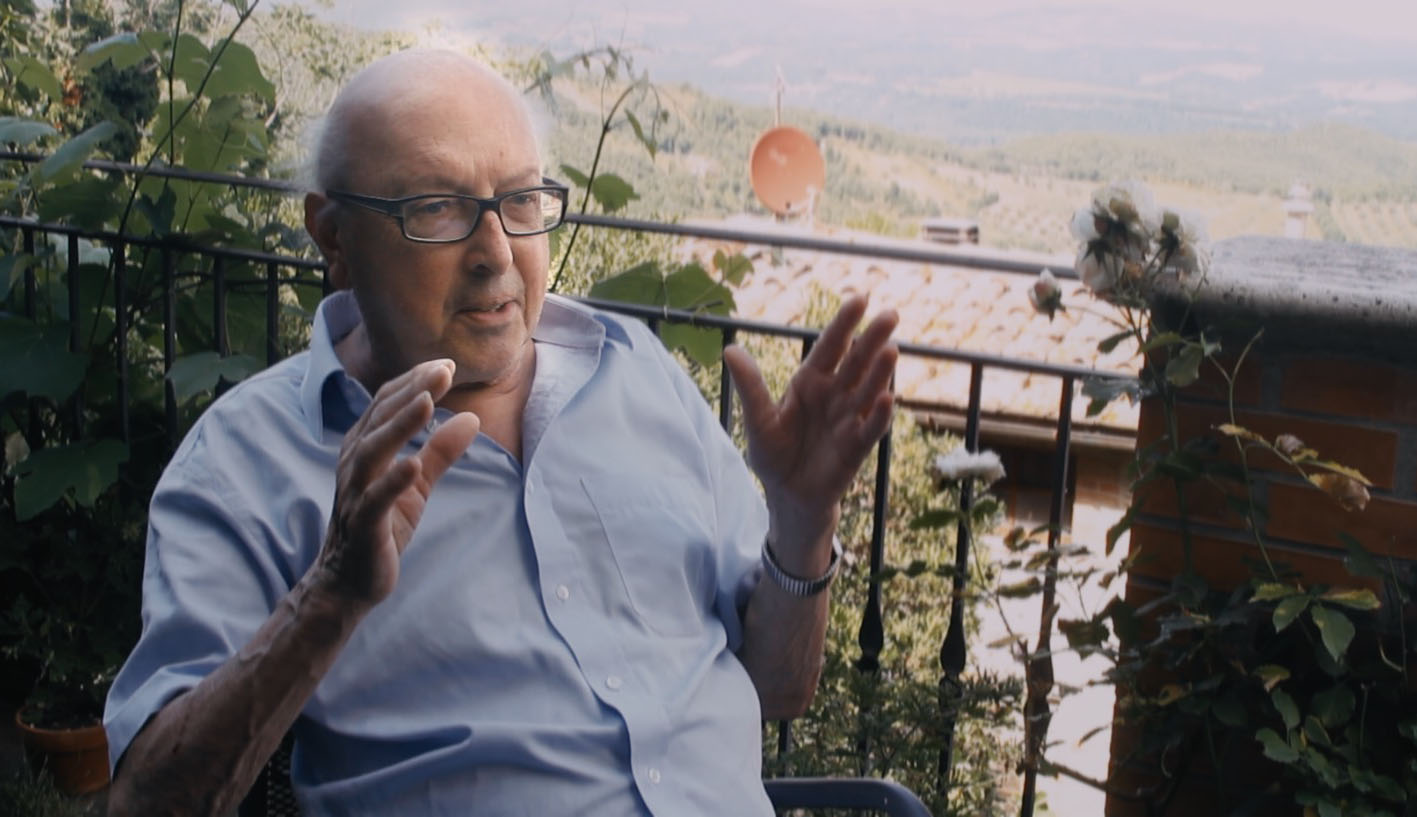 Dr David Peat (1938–2017), physicist, a student of Bohm’s who has played a central role in safeguarding his legacy. He wrote a biography, entitled Infinite Potential,[4] and established the Pari Centre of New Learning in Tuscany, Italy, as a centre where people from all disciplines can continue to explore his ideas. Photograph: from the film Infinite Potential: The Life & Ideas of David Bohm Early Life and Exile. But then two things happened. Firstly, in the era of the McCarthy hearings, he was targeted because of a brief membership of the Communist Party (which he had joined, as his colleague Basil Hiley explains in the film, because he hoped to discuss the philosophy of Hegel!) and was called before the Congressional Committee. Refusing to give names of associates, he was arrested for contempt of Congress. Although he was subsequently released without charge, he lost his job, and had to leave the country to find work. This took him firstly to Brazil, then to Israel and the UK, where he worked at Bristol University and finally, in the years leading up to his death in 1992, at Birkbeck College in London. Secondly, whilst in Brazil, he published a paper entitled ‘A Suggested Interpretation of Quantum Mechanics in Terms of “Hidden Variables”’.[1] This was a reformulation of quantum mechanics which attempted to address the fundamental indeterminacy expressed in the ideas of Niels Bohr, which at the time were becoming codified as ‘The Copenhagen Interpretation’. This paper, Paul explains in the film, would become a key component of Bohm’s intellectual legacy in the decades to come: “But in 1952, it sparked hostility and served to finish him in the eyes of the physics orthodoxy. He sent it for publication believing that it would act as a shock wave to physicists.” But in fact he received no substantial response, either then or later. It was only years afterwards that he found out why. The film reveals that the paper was actively vetoed by Oppenheimer, then one of the most powerful figures in the physics world, having co-ordinated the war-time atomic bomb project at Los Alamos. Finding that there was no mathematical flaw in Bohm’s approach, Oppenheimer issued an instruction to his fellow scientists: “If we cannot disprove Bohm, then we must agree to ignore him.” This resulted in Bohm being effectively ostracised by major sections of the physics community for the rest of his life. For anyone who retains a belief that science is an open-ended exploration of reality, this incident is truly shocking, especially as it was evident to those of us who knew Bohm that his exile was a source of deep sadness. Paul, however, thinks that there was an upside. “David was an extremely open-minded person, and I believe that this is the underlying reason why he had to move away from the élite scientists in Princeton during those dreadful McCarthy years. If one is sincere in one’s pursuits in life, sometimes you have to go your own way. I never knew David personally, but I have spoken to many people who did and it is clear that he was a very humble and modest person. But nevertheless, this is what he did – go his own way. So in a way you could say that Oppenheimer and the other physicists who went along with him did Bohm a favour. If he had not had to go into exile in Brazil, he may never have written that paper and could possibly have had a very safe career. And of course, this hidden variables paper that was discarded earlier on has now risen from the ashes, so to speak.” 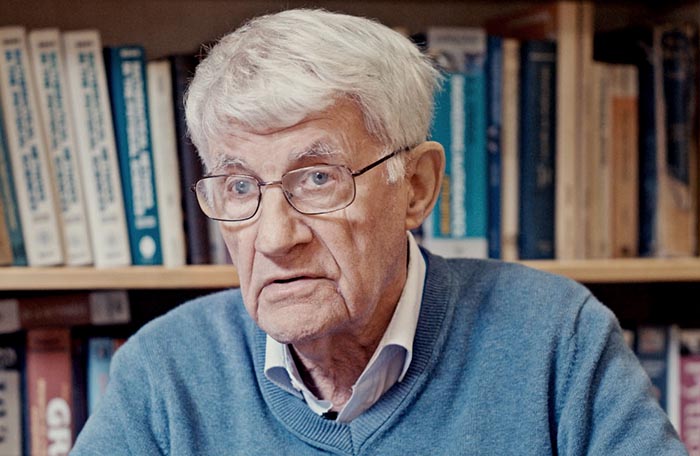 Professor Basil Hiley, physicist, University College London. He was Bohm’s close collaborator, co-authoring his final book The Undivided Universe,[3] and has continued to develop his ideas. He is currently heading a project aiming to prove the existence of the quantum potential experimentally.
Hidden Variables. Bohr, however, believed that this underlying ‘wholeness’ could not be probed further or really understood; all that is possible is to develop equations to describe phenomena, and these, because of the indeterminacy expressed by Heisenberg’s uncertainty principle, use statistical methods to describe quantum behaviour. It was this aspect of the theory which led Einstein to famously remark: “God does not play dice.” By contrast, Bohm’s paper proposed that the behaviours of quantum particles are not chance events, but are guided by what he called ‘pilot waves’. These cannot be observed but nevertheless they control a particle’s trajectory and can be mathematically expressed. Receiving no positive response to the notion, however, he moved on in the following decades to develop another – although related – theory which in his seminal 1980s publication he called the ‘implicate order’ [2] and in his posthumously published masterwork, co-authored with Basil Hiley, ‘an ontological interpretation of quantum mechanics’. [3] 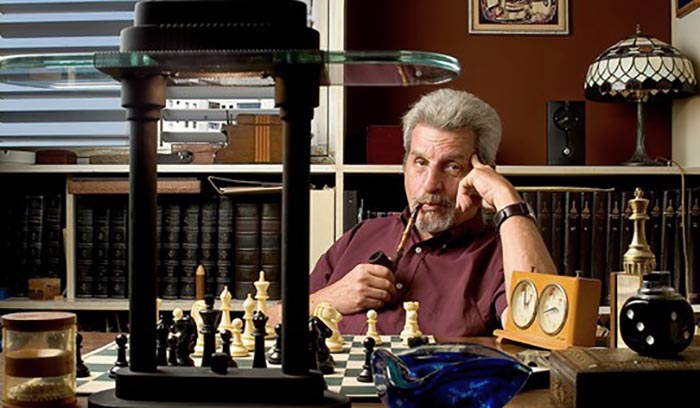 Professor Yakir Aharonov, theoretical physicist, Chapman University, Israel. A student of Bohm, he is best known for his work on the Aharonov-Bohm effect for which he received the prestigious Wolfe Prize in 1998.
Along the way he did some impressive work with Yakir Aharonov on the vector potential, which many people thought worthy of a Nobel Prize in its own right,[4] and through his teaching influenced a generation of young scientists. It was one of his lectures, for instance, that inspired the young John Bell to develop his famous Theorem [/], which led, in 1972, to the experiment on ‘non-locality’ – usually now called ‘quantum entanglement’ – in which quantum particles were shown to transmit information instantaneously, from one end of the universe to the other, across space and time.[5]
Whilst Bohm was caught up in these other projects, the 1952 paper was effectively consigned to the dustbin of history. However, in the 1970s, some of his PhD students at Birkbeck – Chris Philippidis and Chris Dewdney – resurrected it and began to develop it for a new generation. Instead of using the term ‘hidden variables’ they talked about the guiding pilot wave as ‘the quantum potential’, and, using the sophisticated computing technology that had become available in the intervening decades, were able to show that Bohm’s equations accounted for all the quantum phenomena described by the orthodox theory, including non-locality. They therefore proved his approach to be a viable alternative. But Bohm’s theory has one big advantage over the standard approach: Dewdney was able to create a graphic simulation of the way in which the quantum potential guides the electron during the two-slit experiment, providing a means of conceiving what is really happening. This was radical. One physicist, shocked when seeing the simulations for the first time, called them ‘the hard porn of physics’ because, he said, “you shouldn’t be able to see this stuff”!  One of the simulations done at University College London, showing the behaviour of electrons in the two-slit experiment
Some of these videos are included in Infinite Potential, with Chris Dewdney himself advising on the computer graphics. We mention to Paul how struck we have been by the visual effects in the film in general. “As a director,” he explains, “I see it as my job to make the physics as accessible as possible to a general audience. We were very concerned that the film should have high production values: good cinematography, a lovely sound track and so on. We created some very beautiful animations to portray these subtle quantum effects. Unfortunately, many of these had to be cut from the short version of the film; we originally made it to be 110 minutes in length, but then the distributors wanted it shorter, so we had to cut 38 minutes. This was very painful for me; we lost quite a bit of science, including the material on the Aharonov-Bohm effect and the section with Dr Leroy Little Bear on the Blackfoot language.” The longer version, however, is available as ‘the directors cut’, and is being shown at selected events and conferences (click here [/] for information on upcoming events). It will also be released in full for broadcast later this year, and there is a possibility of it being adapted as a two- or three-part series. If this happens, Paul plans to add another part on Bohmian dialogue. “This was quite a big part of David’s life in the years before his death, and is essential to understanding how his theories find application at a political or social level. But there was so much to cover – David’s scope being so wide – that we could not fit it into the first version.” 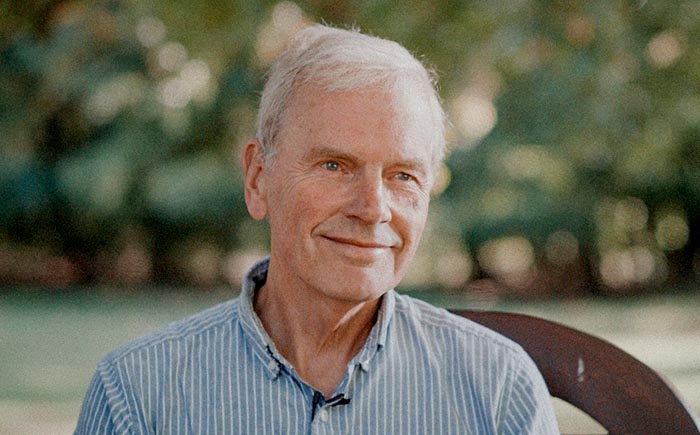 Dr Chris Dewdney, Reader in Theoretical Physics, University of Portsmouth, UK. A student of Bohm and Hiley, he was a key figure in the development of Bohm’s hidden variable paper and masterminded the computer simulations of the behaviour of quantum particles in the two-slit experiment. Photograph: from the film Infinite Potential: The Life & Ideas of David Bohm A New Philosophy for Life. But the real importance of Bohm’s ideas, Paul believes, is that they provide a philosophy of life which is soundly based upon science – which is comfortable with science and the ideas coming out of quantum mechanics. “The 400,000 or more people who have viewed the film are not all scientists. I think there are many people these days who are feeling a little lost and confused; there is a lot of incoherence and fragmentation out there. There is a collective sense in society now that we need to come back to a sense of connectedness, both with ourselves and with other people – and also the natural world. So I think that the philosophical aspects of the film will resonate with such an audience.” 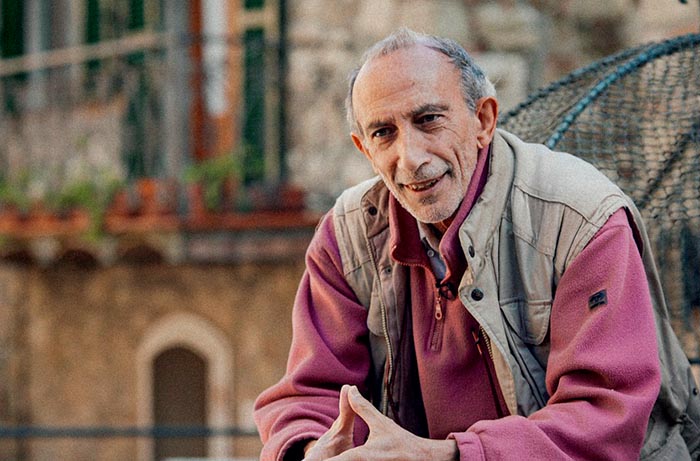 Shatena Augusto Sabbadini, quantum physicist and philosopher. He is currently Director of the Pari Centre for New Learning in Tuscany, which continues to be an important centre for the exploration of Bohm’s ideas in all realms of knowledge. Photograph: from the film Infinite Potential: The Life & Ideas of David Bohm So what are these philosophical ideas that have such wide appeal now? “Well, most importantly, Bohm’s theories are rooted in the idea of wholeness. When thinking about ways of bringing together quantum mechanics and relativity, he saw very early on that the notion of undivided wholeness is the common ground between them. His solution was to propose that everything that we see in our everyday world of space and time – what he called the ‘explicate order’ – is in fact interconnected and not separate at a deeper level of reality – which he called the ‘implicate order’. This is because they are part of a single system where separation does not exist.”
Bohm’s understanding of this interconnectedness is that it is internal, not external. And this is of course just what the quantum phenomenon of non-locality shows us; particles seem to communicate instantaneously, violating a central tenet of relativity that information cannot be transmitted faster than the speed of light. It is this sense of interior unity, Paul feels, which is so important. It led Bohm beyond the confines of science to an interest in the nature of consciousness, and to engagement with non-Western traditions, such as Buddhism, where this has been explored through contemplation. The best-known of these encounters were his dialogues, over a period of 25 years, with the Indian philosopher and mystic, Krishnamurti.[6] “David saw life as an indivisible whole, which includes nature and also our own consciousness. In Krishnamurti, he found someone who also had this notion. As we try to show, Krishnamurti helped him explore the nature of thought and the way that ideas emerge out of this hidden order, the implicate order, just as quantum particles do.” 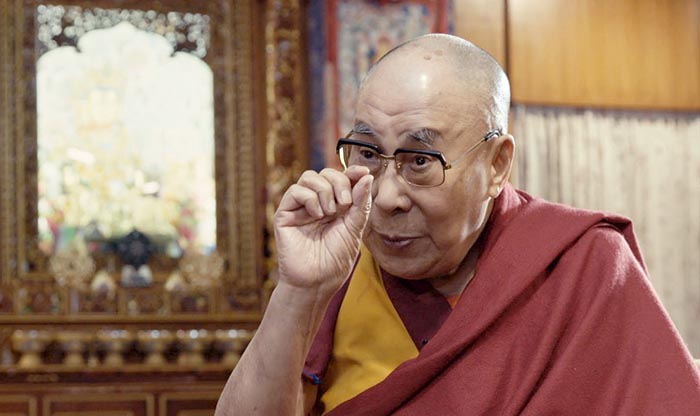 H. H. The Dalai Lama, the spiritual leader of Tibet. He is deeply committed to a vision that embraces both science and spirituality, and had a close relationship with Bohm, with whom he had extensive discussions in the years leading up to his death.
So this is perhaps a major contribution that Bohm’s thought can make in today’s fragmented world; it promises a realignment between our interior experience and external reality which was lost with the scientific revolution. Paul agrees: “Science and religion were unified at one point in the quest for spirituality and truth. But in recent centuries, they have become disconnected. When I was young, my father, who read widely in science and religion, used to talk to me a lot about Biblical references like the ‘kingdom of heaven’. This kind of religious language is not something that many people use nowadays, but he explained to me that what Christ was basically talking about is another dimension of reality. And this coheres with what Bohm is saying: that what we see here, in this physical world, is constantly emerging from the non-material level of the implicate order.” He goes on: “It is hard to explain this to people in an ordinary situation, because the tools that we use to understand this ‘explicate’ order of reality – sense perception, linear measurement and linear time – are not the same tools that we need to understand this deeper order. In fact, they can in some ways be obstacles if you try and use them in that world where time is not linear and the space between objects is irrelevant. But we can develop other faculties, more subtle senses, by which we can know something of it.” 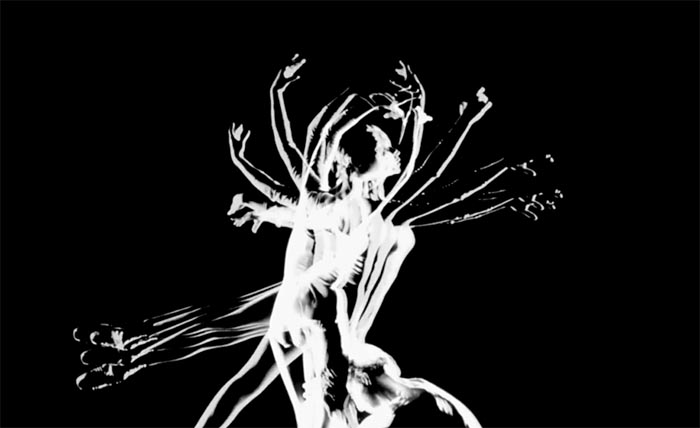 Still from the film, showing the process of unfolding/enfolding which is at the heart of Bohm’s understanding of the implicate order.
An important aspect of Bohm’s theory, we suggest, is that it manages to encompass both the implicate and explicate levels of existence by explaining in mathematical terms the process of emergence – or, as he tends to call it, unfoldment – of one into the other. One of the most beautiful animations in the film demonstrates this as a dance, with a voice-over by Basil Hiley:
Wholeness means that we cannot analyse things as we used to by cutting things up into little bits as we do in classical physics. If we want to analyse it, we cut it up by saying that the way one bit goes into the next bit involves unfolding into the whole and then enfolding back into a particular region. So you get a process of unfolding/enfolding/unfolding/enfolding, and what looks like a continuous trajectory is actually a series of enfoldings and unfoldings. Paul agrees, and points out that we can witness this process of unfoldment for ourselves in almost every area of life if we really understand these ideas. “For example, when we go deeply into any subject, moving beyond a merely superficial engagement with it, it kind of opens up for us and we come to a new perception. And where that new perception comes from is an illustration of how the implicate becomes the explicate. David’s view was that nature has an infinite quality – the more we explore, the more questions come up. And each question provides us with more answers, and these in turn generate even more questions. So we keep finding more and more structure as we go into nature. I think this is why David thought that it was a mistake to think that we will ever come up with a ‘theory of everything’. We will keep on embracing new dimensions of reality.” 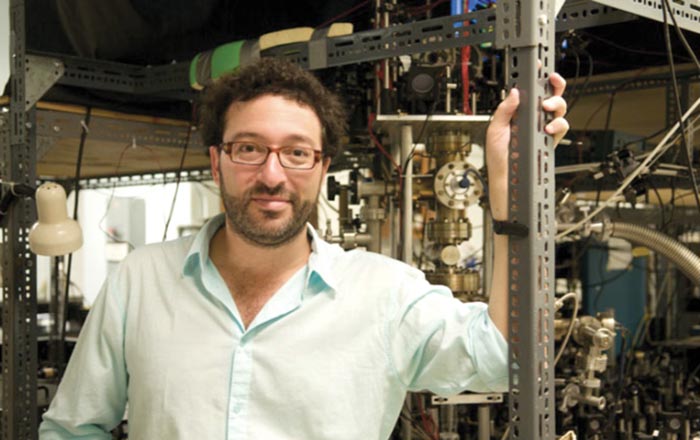 Aephraim Steinberg, experimental quantum physicist, University of Toronto, Canada. One of the new generation of physicists working on developing ontological approaches to quantum mechanics.
Ways Forward. The film has already had showings in a wide variety of venues, including the celebrations for the Dalai Lama’s 85th birthday, and, following the spirit of enquiry and openness which characterised Bohm’s own approach, each has been followed by a panel discussion to explore contemporary implications. It has been sponsored by the Fetzer Memorial Trust [/], which supported Bohm himself when he was alive, and most events are generously accessible without charge. Paul explains: “We are not concerned with making a lot of income on the film; it is a question of getting the message out to as many people as possible. If we do end up earning income, then it will be re-invested into the shelf life of the film, so that if any new ideas come up – for instance, if the quantum potential is proven – then we can update accordingly”. One thing that is certain is that there would be radical implications should Bohm’s vision become widely accepted. Jan Walleczek [/], Director of Phenoscience Laboratories in Berlin and of the Fetzer Memorial Trust, says towards the end of the film: [Bohm’s theory] really says that there is a hidden regime of reality in which everything is interconnected, but no person, even in the future, will be able to access that domain and control it. This is also what the mystical traditions tell us; that we must be humble in the face of reality, that there will be domains of reality that remain beyond science, beyond the scientific method… If the quantum potential is discovered, if non-locality is proven, then the existence of that domain is proven… This would revolutionise the scientific worldview, and it would validate those views of unification, those views that speak to the holism of the universe. It would be confirmation of the kind of holism that religions and spiritual systems and mystical systems have intuited for many centuries. To watch the film (available free of charge for a limited period of time), and find out more about the participants and future events, click here [/].
Antony Gormley’s ‘Quantum Cloud’, installed next to the Millenium Dome in London. The idea of the sculpture came from a conversation between the artist, David Peat and Basil Hiley at the Pari Centre. As the viewer moves around the installation, they may or may not see the figure of a man at its centre. Says Gormley: “My interest in David Bohm was this notion that everything is becoming. Everything is in a state of emergence. Quantum Cloud is my clumsy way of saying: We are not just things in space. We are places of transformation.”
|
||
|
|
